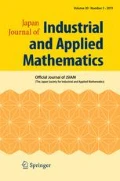Abstract
For a second order nonautonomous singularly perturbed ordinary differential equation with Neumann boundary conditions, the existence of single transition layer solutions is proved by using the method of Liapunov-Schmidt. The method also gives the stability of these solutions as an equilibrium point of a parabolic equation.
Similar content being viewed by others
References
S. B. Angenent, J. Mallet-Paret and L. A. Peletier, Stable transition layers in a semilinear boundary value problem. J. Differential Equations,67 (1987), 212–242.
S.-N. Chow and J. K. Hale, Methods of Bifurcation Theory. Grundl. Math. Wiss., Vol. 251, Springer-Verlag.
P. C. Fife, Transition layers in singular perturbation problems. J. Differential Equations,15 (1974), 77–105.
P. C. Fife, Boundary and interior transition layer phenomena for pairs of second order differential equations. J. Math. Anal. Appl.,54 (1976), 497–521.
H. Fujii and Y. Nishiura, Stability of singularly perturbed solutions to systems of reaction diffusion equations. Proc. Japan Acad.,61 (1985), 329–332. Complete proofs in KSU/ICS, 85-05, Inst. Computer Sci. Kyoto Sangyo Univ.
G. Fusco and J. K. Hale, Stable equilibria in a scalar parabolic equation with variable diffusion. SIAM J. Math. Anal.,16 (1985), 152–164.
J. K. Hale, Introduction to dynamic bifurcation. Bifurcation Theory and Applications (Ed. L. Salvadori), Lecture Notes in Math., Vol. 1057, Springer-Verlag, 106–151.
J. K. Hale and C. Rocha, Bifurcations in a parabolic equation with variable diffusion. Nonlinear Anal. TMA,9 (1985), 479–494.
M. Ito, A remark on singular perturbation methods. Hiroshima Math. J.,14 (1984), 619–629.
C. Jones, Stability of the travelling waves solution of the Fitz-Hugh-Nagumo equations. Trans. Amer. Math. Soc.,286 (1984), 431–469.
H. Matano, Asymptotic behavior and stability of solutions of semilinear diffusion equations. Publ. Res. Inst. Math. Sci., Kyoto Univ.,15 (1979), 401–454.
M. Mimura, M. Tabata and Y. Hosono, Multiple solutions of two point boundary value problems of Neumann type with a small parameter. SIAM J. Math. Anal.,11 (1980), 613–631.
C. Rocha, Generic properties of equilibria of reaction diffusion equations with variable diffusion. Proc. Roy. Soc. Edinburgh,101A (1985), 45–55.
C. Rocha, Examples of attractors in scalar reaction-diffusion equations. J. Differential Equations, Submitted.
K. Sakamoto, Construction and stability analysis of transition layer solutions in reaction-diffusion systems. To appear.
Author information
Authors and Affiliations
Additional information
This research was supported in part by the Army Research Office under contract # DAAL03-86-K-0074, the Air Force Office of Scientific Research under contract # AF: OSR-84-0376, and the National Science Foundation under contract # DMS-8507056.
About this article
Cite this article
Hale, J.K., Sakamoto, K. Existence and stability of transition layers. Japan J. Appl. Math. 5, 367–405 (1988). https://doi.org/10.1007/BF03167908
Received:
Issue Date:
DOI: https://doi.org/10.1007/BF03167908


